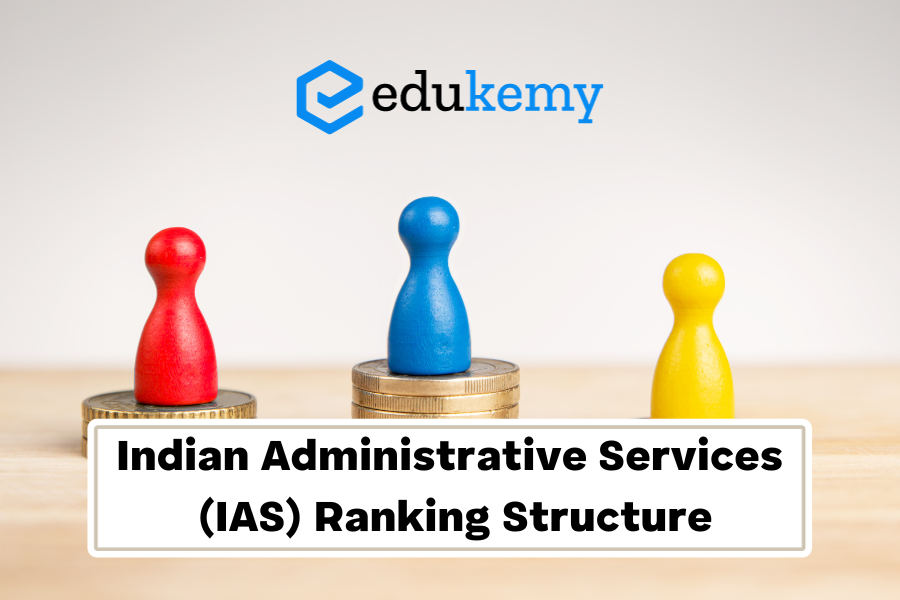
Indian Administrative Services forms one of the three pillars on which lies the implementation of the Indian Constitution. (The three pillars are Legislature, Executive, and Judiciary.) Therefore, on-ground implementation of any government policy, law, order, etc. relies on the proper functioning of the complete executive machinery, the framework of which is formed by the Indian Administrative Services.
IAS officers are directly appointed by the President of India and are an inseparable branch of the Indian Government. IAS Rank structure allows proper functioning and management of key strategic positions responsible for the proper functioning of the Government.
There are three primary routes through which IAS officer recruitment is completed, and within years they are allocated different IAS Ranks in India. For separate IAS Rank Wise Posts, the ratio between direct recruits and promotes has been 2:1
- UPSC Civil Services Examination: More than 10 Lakh applicants appear for the UPSC IAS exam. Only 180 students are allotted to IAS posts out of those millions, which trickles down to a feeble probabilistic percentage. Students undergo several years of preparation for the coverage of a vast syllabus from a list of subjects. The Civil Services Examination has 3 phases which are Prelims, Mains, and Personality Test. At the same time, the students have to strategize different sets of plans for every stage. The Prelims examination has objective questions and requires students to solve questions within a short period. For UPSC Mains Examination, aspirants have to frame explanatory answers for the case-based questions, and it spans over 10 days for a set of different papers. Finally, students who clear these two phases appear for the final round of the personality test, which is the IAS interview. With eminent board members from different areas of expertise, test the aspirant’s wit and knowledge.
- Promotion from State Civil Service Officers: A separate service cadre exists for the government for every state. In general administration and management of revenue, there are several sub-divisional posts to serve greater responsibility. However, after a certain set of years, these state officers become eligible for the promotion. A committee decides them, and the Central Government determines the promotions after consultation with the State Government. At the beginning of every year, on the first day of January, posts are rolled out. The classified list of candidates who must have completed a minimum of 8 years of continuous service in the position of Deputy collector or any equivalent post is eligible for the promotion.
- Promotion from Non-State Civil Services: According to the requirement and regulations of the Indian Administrative Services, the state government declares several vacancies. The Non-State Civil Services referred above equivalent to the post of Deputy Collected in State Administrative services and who have completed not less than 8 years of services in the positions of Class-I rank will be appointed for IAS selection.
There are certain IAS Rank Wise Posts that the officers hold during their allocation are:
- SDO/SDM/Joint Collector/ Chief Development Officer (CDO)
- District Magistrate/District Collector/Deputy Commissioner
- Divisional Commissioner
- Member Board of Revenue
- Chairman of Revenue
Even after these allocations, the IAS officers can work in several other coveted nationalized and international organizations for a fixed tenure. Therefore, a particular IAS Rank structure is required for various crucial decision-making areas present in the Ministries of Government and are responsible for serving their Nation as per the oath taken.
Contents
- 1 Frequently Asked Questions (FAQs)
- 1.1 Q: What is the hierarchy of ranks for an IAS officer?
- 1.2 Q: How is the promotion process for IAS officers determined?
- 1.3 Q: What are the responsibilities associated with each rank in the IAS?
- 1.4 Q: Can an IAS officer be de-ranked or demoted?
- 1.5 Q: How does the pay scale correspond to the ranking structure of IAS officers?
- 2 In case you still have your doubts, contact us on 9811333901.
Frequently Asked Questions (FAQs)
Q: What is the hierarchy of ranks for an IAS officer?
The Indian Administrative Service (IAS) officer ranks follow a hierarchical structure. The entry-level position is that of a Junior Scale Officer, followed by the Senior Time Scale, Junior Administrative Grade, Selection Grade, and the highest level, Super Time Scale. Understanding this hierarchy is crucial for career progression in the civil services.
Q: How is the promotion process for IAS officers determined?
Promotion in the IAS is primarily based on the officer’s performance, experience, and seniority. Regular assessments, Annual Confidential Reports (ACRs), and a competitive examination process contribute to an officer’s eligibility for promotion to the next grade. The promotion process is designed to ensure that individuals with proven competence and dedication move up the ranks.
Q: What are the responsibilities associated with each rank in the IAS?
The responsibilities of an IAS officer vary with their rank. Junior Scale Officers often start with field assignments and grassroots-level administration, while officers in higher grades may handle district-level administration, policy formulation, and implementation. Super Time Scale officers are often entrusted with significant roles at the state and central government levels, dealing with major policy decisions.
Q: Can an IAS officer be de-ranked or demoted?
While the IAS officer’s rank is generally expected to increase with time and experience, there are instances where an officer may face disciplinary actions or a performance-related setback. In such cases, the government may initiate proceedings that could lead to a reduction in rank or even dismissal. However, such instances are relatively rare and are subject to a thorough and transparent review process.
Q: How does the pay scale correspond to the ranking structure of IAS officers?
The pay scale for IAS officers is linked to their rank. As officers move up the hierarchy, their salaries increase accordingly. In addition to the basic pay, IAS officers are entitled to various allowances and benefits. Understanding the pay scale associated with each rank is essential for officers to plan their finances and make informed career decisions.
In case you still have your doubts, contact us on 9811333901.
For UPSC Prelims Resources, Click here
For Daily Updates and Study Material:
Join our Telegram Channel – Edukemy for IAS
- 1. Learn through Videos – here
- 2. Be Exam Ready by Practicing Daily MCQs – here
- 3. Daily Newsletter – Get all your Current Affairs Covered – here
- 4. Mains Answer Writing Practice – here

